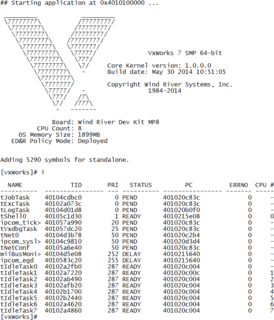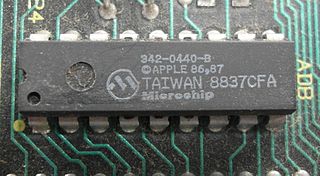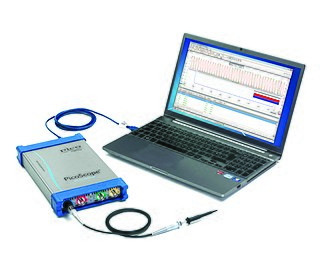Bluetooth is a short-range wireless technology standard that is used for exchanging data between fixed and mobile devices over short distances using UHF radio waves in the ISM bands, from 2.402 GHz to 2.48 GHz, and building personal area networks (PANs). It is mainly used as an alternative to wire connections, to exchange files between nearby portable devices and connect cell phones and music players with wireless headphones. In the most widely used mode, transmission power is limited to 2.5 milliwatts, giving it a very short range of up to 10 metres (33 ft).

VxWorks is a real-time operating system developed as proprietary software by Wind River Systems, a wholly-owned subsidiary of Aptiv. First released in 1987, VxWorks is designed for use in embedded systems requiring real-time, deterministic performance and, in many cases, safety and security certification for industries such as aerospace and defense, medical devices, industrial equipment, robotics, energy, transportation, network infrastructure, automotive, and consumer electronics.

Electronic test equipment is used to create signals and capture responses from electronic devices under test (DUTs). In this way, the proper operation of the DUT can be proven or faults in the device can be traced. Use of electronic test equipment is essential to any serious work on electronics systems.
Teledyne Technologies Incorporated is an American industrial conglomerate. It was founded in 1960, as Teledyne, Inc., by Henry Singleton and George Kozmetsky.
Nucleus RTOS is a real-time operating system (RTOS) produced by the Embedded Software Division of Mentor Graphics, a Siemens Business, supporting 32- and 64-bit embedded system platforms. The operating system (OS) is designed for real-time embedded systems for medical, industrial, consumer, aerospace, and Internet of things (IoT) uses. Nucleus was released first in 1993. The latest version is 3.x, and includes features such as power management, process model, 64-bit support, safety certification, and support for heterogeneous computing multi-core system on a chip (SOCs) processors.

Automatic test equipment or automated test equipment (ATE) is any apparatus that performs tests on a device, known as the device under test (DUT), equipment under test (EUT) or unit under test (UUT), using automation to quickly perform measurements and evaluate the test results. An ATE can be a simple computer-controlled digital multimeter, or a complicated system containing dozens of complex test instruments capable of automatically testing and diagnosing faults in sophisticated electronic packaged parts or on wafer testing, including system on chips and integrated circuits.

Wireless USB was a short-range, high-bandwidth wireless radio communication protocol created by the Wireless USB Promoter Group which intended to increase the availability of general USB-based technologies. It was unrelated to Wi-Fi, and different from the Cypress WirelessUSB offerings. It was maintained by the WiMedia Alliance which ceased operations in 2009. Wireless USB is sometimes abbreviated as "WUSB", although the USB Implementers Forum discouraged this practice and instead prefers to call the technology Certified Wireless USB to distinguish it from the competing UWB standard.

A bus analyzer is a type of a protocol analysis tool, used for capturing and analyzing communication data across a specific interface bus, usually embedded in a hardware system. The bus analyzer functionality helps design, test and validation engineers to check, test, debug and validate their designs throughout the design cycles of a hardware-based product. It also helps in later phases of a product life cycle, in examining communication interoperability between systems and between components, and clarifying hardware support concerns.

Microchip Technology Inc. is a publicly-listed American corporation that manufactures microcontroller, mixed-signal, analog and Flash-IP integrated circuits. Its products include microcontrollers, Serial EEPROM devices, Serial SRAM devices, embedded security devices, radio frequency (RF) devices, thermal, power and battery management analog devices, as well as linear, interface and wireless products.
A Bluetooth stack is software that is an implementation of the Bluetooth protocol stack.
NeSSI is a global and open initiative sponsored by the Center for Process Analysis and Control (CPAC) at the University of Washington, in Seattle.
ANT is a proprietary multicast wireless sensor network technology designed and marketed by ANT Wireless. It provides personal area networks (PANs), primarily for activity trackers. ANT was introduced by Dynastream Innovations in 2003, followed by the low-power standard ANT+ in 2004, before Dynastream was bought by Garmin in 2006.
Bluetooth Low Energy is a wireless personal area network technology designed and marketed by the Bluetooth Special Interest Group aimed at novel applications in the healthcare, fitness, beacons, security, and home entertainment industries. It is independent of classic Bluetooth and has no compatibility, but Bluetooth Basic Rate/Enhanced Data Rate (BR/EDR) and LE can coexist. The original specification was developed by Nokia in 2006 under the name Wibree, which was integrated into Bluetooth 4.0 in December 2009 as Bluetooth Low Energy.

Silicon Laboratories, Inc. is a fabless global technology company that designs and manufactures semiconductors, other silicon devices and software, which it sells to electronics design engineers and manufacturers in Internet of Things (IoT) infrastructure worldwide.

Stonestreet One was a software company specializing in Bluetooth software solutions. Founded in 1999 in Louisville, Kentucky, Stonestreet One created and sold software for the Bluetooth wireless technology industry. They specialized in solutions for chipmakers, distributors, embedded software companies and Original Equipment Manufacturers. Stonestreet One was acquired by Qualcomm in 2014.

An RF module is a (usually) small electronic device used to transmit and/or receive radio signals between two devices. In an embedded system it is often desirable to communicate with another device wirelessly. This wireless communication may be accomplished through optical communication or through radio-frequency (RF) communication. For many applications, the medium of choice is RF since it does not require line of sight. RF communications incorporate a transmitter and a receiver. They are of various types and ranges. Some can transmit up to 500 feet. RF modules are typically fabricated using RF CMOS technology.

ATEN International Co., Ltd is a Taiwanese multinational manufacturer of connectivity and access management hardware headquartered in Xizhi District, New Taipei, Taiwan. Its products include KVM switches, audiovisual switches and matrices, intelligent power distribution units, information technology management systems, and interface adapters. ATEN has subsidiaries in several countries and is the parent company of IOGEAR. The company is currently the largest KVM switch manufacturer in the world.

Pico Technology is a British manufacturer of high-precision PC-based oscilloscopes and automotive diagnostics equipment, founded in 1991. Their product range includes the PicoScope line of PC-based oscilloscopes, data loggers, automotive equipment, and most recently, handheld USB-based oscilloscopes. Since their inception in 1991, Pico Tech has been researching and developing PC-based oscilloscopes, when the market standard was analogue storage oscilloscopes. Pico Technology is one of two European scope manufacturers, and competes in the low to middle end of the instrumentation market.

LeCroy Corporation is an American manufacturer of oscilloscopes, protocol analyzers and other test equipment. LeCroy is now a subsidiary of Teledyne Technologies.











